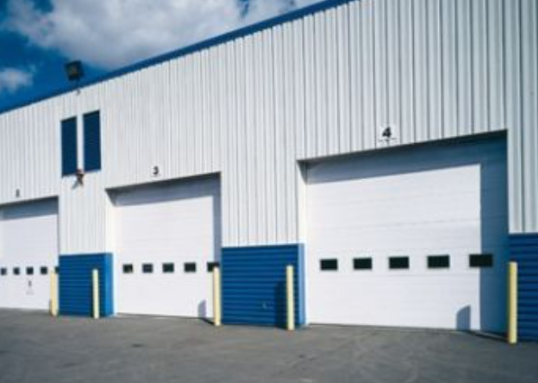Commercial overhead doors play a critical role in the operations of many businesses, from warehouses and manufacturing facilities to automotive shops and retail spaces. These doors are designed to handle frequent use, provide security, and improve efficiency. Choosing the right commercial overhead door can significantly impact your building’s functionality, energy efficiency, and safety.
This article explores the key features, benefits, types, and maintenance considerations of commercial overhead doors.
1. What Are Commercial Overhead Doors?
Commercial overhead doors, also known as sectional doors or industrial garage doors, are large doors typically made of steel, aluminium, or fibreglass panels. They are mounted on tracks and open vertically, rolling along the ceiling when raised. These doors are designed for durability and high performance in demanding commercial and industrial environments.
They are commonly found in:
- Warehouses
- Loading docks
- Fire stations
- Automotive service centers
- Storage facilities
- Retail storefronts
2. Types of Commercial Overhead Doors
- Sectional Steel Doors
Sectional doors are made up of several horizontal panels hinged together. They are highly durable and can be insulated for energy efficiency. Sectional steel doors are ideal for warehouses and garages that require frequent operation and added security. - Rolling Steel Doors
Although technically a separate category, rolling steel doors are often considered a type of overhead door. These doors roll up into a compact coil above the opening and are ideal for locations with limited ceiling space. - Aluminum Glass Doors
Aluminum glass overhead doors are popular in modern commercial settings, especially for automotive showrooms, restaurants, or retail spaces. They offer a clean, professional look while allowing visibility and natural light. - High-Speed Doors
High-speed overhead doors are designed for environments where fast access is essential, such as in cold storage or high-traffic areas. These doors open and close rapidly, reducing energy loss and improving workflow.
3. Key Features of Commercial Overhead Doors
- Durability
Commercial overhead doors are built for heavy use. Most are constructed from high-strength materials like galvanized steel or reinforced aluminium, offering excellent resistance to impact, weather, and wear. - Insulation
Many overhead doors include insulation, typically in the form of polyurethane or polystyrene cores. Insulated doors help regulate interior temperatures, reduce energy costs, and minimise noise. - Safety Mechanisms
Modern commercial overhead doors include safety features such as:
- Photo-eye sensors to detect obstructions
- Manual release systems in case of power failure
- Safety edges to prevent injury if something is in the door’s path
Customization
Overhead doors can be customized in terms of size, color, finish, windows, and level of insulation to match the aesthetic and functional needs of a business.
4. Benefits of Commercial Overhead Doors
- Enhanced Security
These doors provide strong protection against unauthorised access and potential theft. Reinforced materials and locking mechanisms help ensure that the facility remains secure during and after business hours. - Energy Efficiency
Insulated overhead doors reduce heat loss in the winter and keep interiors cool in the summer. This can significantly lower heating and cooling costs, especially in climate-controlled environments like warehouses and food storage facilities. - Operational Efficiency
Overhead doors can be equipped with automated openers and remote systems for easy operation. This is particularly beneficial in busy settings where vehicles and personnel need to move quickly and efficiently. - Noise Reduction
In noisy environments, such as factories or workshops, insulated commercial doors can help reduce sound transmission between different areas, contributing to a more comfortable work environment.
5. Applications of Commercial Overhead Doors
- Warehouses and Distribution Centres
Overhead doors are essential for loading docks and delivery areas, where fast and efficient access is crucial for logistics operations. - Automotive Shops and Dealerships
Service bays and showrooms benefit from glass-panel overhead doors, which offer easy access and showcase vehicles attractively. - Fire Stations
Speed and reliability are critical in emergency response facilities. High-performance overhead doors ensure fire trucks can deploy without delay. - Retail and Food Service
Overhead doors can separate indoor and outdoor seating areas in cafes or open up retail spaces during business hours, improving customer engagement and accessibility.
6. Maintenance and Safety Tips
To ensure optimal performance and longevity, regular maintenance of commercial overhead doors is essential:
- Inspect and Lubricate Moving Parts: Rollers, hinges, and tracks should be lubricated regularly to reduce wear and noise.
- Check for Wear and Damage: Look for signs of rust, cracks, or worn-out weatherstripping. Damaged panels or broken springs should be repaired promptly.
- Test Safety Features: Ensure that auto-reverse functions and photo-eye sensors are working properly to prevent accidents.
- Professional Inspections: Schedule regular inspections with a qualified technician to catch small problems before they become major issues.
7. Conclusion
Commercial overhead doors are vital components of many business operations. Their strength, versatility, and ease of use make them an ideal solution for a wide range of industries. By selecting the right type of door and maintaining it properly, businesses can enhance security, improve energy efficiency, and streamline operations.
Whether you’re outfitting a new facility or upgrading existing infrastructure, investing in high-quality commercial overhead doors is a smart and long-lasting choice.

